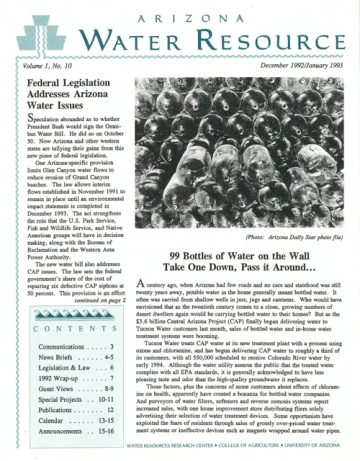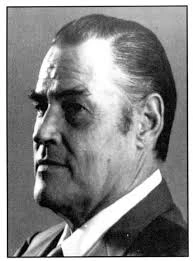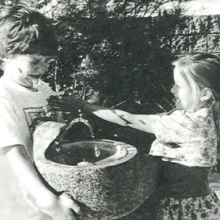
This design for the front page, with its Southwestern Native American motif, defined the AWR for 17 years
The headline for the premier issue of Arizona Water Resource read “State-wide Water Newsletter Debuts,” and the University of Arizona Water Resources Research Center began the uninterrupted 26-year run of its AWR newsletter. According to that first story, AWR was a response to a need, recognized by representatives from various water organizations within the state, for a publication that allows the Arizona water community to share news and information. The information sharing needs that were highlighted included a calendar of events, “information on research and other studies, publication notices, legislative affairs, legal developments, notices of regulations and hearings, notes on transitions, and other types of information of general interest.”
The AWR was developed cooperatively, with input from across the water community. For the first issue, the newsletter team contacted many organizations and invited them to provide material. In that issue, they extended the invitation to include AWR readers, writing “Think of us as a bulletin board for Arizona’s water community. If an item is of interest to you, it probably has wide-spread interest, so please share it.” Contributors were urged to FAX their notices for the sake of timeliness.
This first issue also noted the passing of John W. Harshbarger, founder of the University of Arizona’s Department of Hydrology and Water Resources, who died October 10, 1991, at the age of 77.
The AWR team consisted of Joe Gelt (editor), Todd Sargent (reporter), Jim Suriano (calendar) and Gary Woodard (publisher). They produced ten issues—growing from 8 to 16 pages—in 1992, all printed in black, white and turquoise on recycled & recyclable paper.
In May 1992, the four-months-old AWR congratulated itself on the favorable response within the water community,

John W. Harshbarger
where many individuals contributed content or expressed interest in contributing in the future. Some organizations (ADWR, CAP, SRP, Tucson Water, USGS Water Science Division, and the Water Utilities Association of Arizona) supported AWR through sponsorships. Circulation grew to over 2,500. Over a cover story on the Yuma Desalting Plant and the Ciénega de Santa Clara, was a photo of AWR publisher Gary Woodard’s son and Susanna Eden’s daughter, ages seven and six, playing at a water fountain. (Eden was then a water research specialist at the WRRC).
The first Guest View appeared with the May 1992 issue with three views on CAP underutilization by Dave Iwanski, then at the AgriBusiness Council of Arizona, Mike Brophy, a water attorney with Ryley, Carlock & Applewhite, and Mark Myers, identified as a businessman active in water/environmental issues. Hard as it may be to believe now, 25 years ago underutilization of CAP water was a major problem. A few issues later, Hugh Holub, a water attorney, weighed in on the same subject.
In June 1992, AWR published a letter from Sharon B. Megdal, who was then the Executive Director of the Tucson AMA Water Authority and a member of the Governor ‘s CAP Issues Task Force. Megdal began her letter with evidence that she was an AWR reader: “I enjoyed reading AWR’s guest viewpoints on solutions to CAP underutilization.” Megdal goes on to say that “the problem is complex, and complex problems rarely have simple solutions.” She presents the perspective of the Tucson Active Management Area (AMA), which, she argues, should not be ignored as remedies that support agricultural CAP water use are developed. She wrote, “We must not forget that Arizona’s future is not just the future of the Pinal County farmers or Maricopa County.” The Tucson AMA Water Augmentation Authority, like the problem of CAP underutilization, is long gone, and as a member of the current CAP Board, Megdal is now in a position to represent the Tucson AMA directly.
At the end of its first year, AWR reported the results of a reader survey conducted in October 1992. Of the 248 surveys they mailed via the US Postal Service, about half were returned. The survey indicated that AWR was shared by subscribers with others, turning a circulation of 2,750 into a readership of just over 10,000. Readers included people in education and research, local, state and federal government, engineering and hydrology, water providers, irrigation districts, libraries, environmental organizations, major water users, law firms, and the interested public. The most-read sections of the newsletter were the cover photo and front-page stories; the least-read section, oddly enough, was the calendar. There was a tension between timeliness and depth of coverage, which continues to this day. As a result, the AWR team, with the advice of their cooperators, proposed dropping the calendar. They also promised to try to limit future issues to 12 pages, a promise they largely fulfilled.

Cover photo of Gary Woodard’s son and Susanna Eden’s daughter, ages seven and six, playing at a water fountain.
Topics suggested by survey respondents look very much like today’s issues: environment, water quality and treatment, groundwater hydrology, the Central Arizona Project, Indian water rights, and legislation. Readers liked the range of topics covered and a “large number lauded our willingness to air opposing sides of an issue or unpopular views.” The new publication was more willing to deal with hot-button issues than most such enterprises. The informal and chatty Water Vapors column was inaugurated in the April/May 1993 issue with this statement: “Exhaustive market research indicates that essentially no one reads the Communications section. So, taking a cue from Madison Avenue, we renamed it!” The format was also changed. The June/July column carried the news that the Arizona Hydrological Society had become an AWR sponsor. The Water Vapors column evaporated in 2008.
Over the years, AWR has published Guest Views from a variety of contributors, many of them prominent experts and professionals, including (with their titles as of the time of writing) Arizona State Senator John Mawhinney, Arizona Department of Water Resources Director Rita P. Pearson, and Chief Engineer Herman Bouwer of the U.S. Water Conservation Lab. In January-February 2000, Sharon B. Megdal, then with MegEcon Consulting, provided a Guest View on the need for public discussion of groundwater management 20 years after passage of the Groundwater Management Act.
While Joe Gelt remained editor until 2009, AWR publisher Gary Woodard left the helm in 1999 and contributed his first Guest View as Director of Knowledge Transfer for the Sustainability of Semi-Arid Hydrology and Riparian Areas (SAHRA) center at the end of 2000. Also in 2000, AWR ceased printing on recycled/recyclable paper.
In the January-February 2002 AWR, Sharon B. Megdal’s appointment to the position of WRRC Associate Director was announced, and in the March-April issue the first of her Public Policy Review columns appeared discussing the need to fine-tune the Central Arizona Groundwater Replenishment District (CAGRD).

